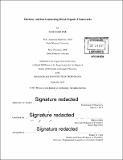Electron- and ion-conducting metal-organic frameworks
Author(s)
Park, Sarah Sunah
DownloadFull printable version (15.21Mb)
Other Contributors
Massachusetts Institute of Technology. Department of Chemistry.
Advisor
Mircea Dincă.
Terms of use
Metadata
Show full item recordAbstract
This thesis focused on designing, characterizing and understanding the electronic or ionic behavior of electron- or ion-conducting metal-organic frameworks (MOFs). Chapter 1 gives a general introduction for electron- or ion-conducting MOFs, including a review of the reported materials exhibiting such behavior. Chapter 2 describes new MOFs designed using through-space charge transport strategies, as introduced in Chapter 1. Chapter 2 discusses four isostructural materials of general formula M2(TTFTB) (M = Mn, Co, Zn, and Cd), which exhibit infinite helical TTF stacks and reveal a correlation between the shortest intermolecular S ... S interaction among neighboring TTF cores and their single crystal conductivity. These results are the first demonstration of tuning intrinsic electrical conductivity of a MOF and provide a systematic blueprint for the design of throughspace charge transporting MOFs. Chapter 3 details the study of ligand-directed topologies in the material Mg₂H₆(H₃O)(TTFTB) 3 (MIT-25), obtained from H₄TTFTB, a ligand with a high propensity toward [pi]-stacking. Because understanding intermolecular [pi]-stacking interactions is important for designing through-space charge transport materials, we studied the significance of how the organic secondary building unit (SBU), which is energetically competitive with the formation of common inorganic SBUs, can also define MOF topology. Chapters 4 and 5 demonstrate examples of MOFs as ionic conductors. In Chapter 4, the proton conductivity of MIT-25 is studied. Owing to its large proton content and compositionally integral hydronium ion, MIT-25 exhibits an strongly hydrophilic environment that facilitates proton conduction. Lastly, Chapter 5 reports a Cu(II)-azolate MOF (MIT-20) with cylindrical pores, which undergoes a reversible single crystal-to-single crystal transition between neutral and anionic phases upon reaction with stoichiometric amounts of halide or pseudohalide salts. By utilizing this transformation, halide/pseudohalide anions are bound to the metal centers and become stationary, while the cations move freely within the one-dimensional pores, giving rise to single-ion Li+, Na+, or Mg²+ solid electrolytes.
Description
Thesis: Ph. D. in Inorganic Chemistry, Massachusetts Institute of Technology, Department of Chemistry, 2017. Cataloged from PDF version of thesis. Vita. Includes bibliographical references (pages 129-136).
Date issued
2017Department
Massachusetts Institute of Technology. Department of ChemistryPublisher
Massachusetts Institute of Technology
Keywords
Chemistry.